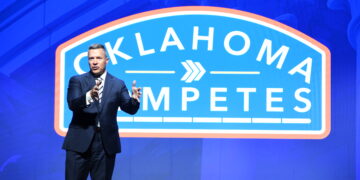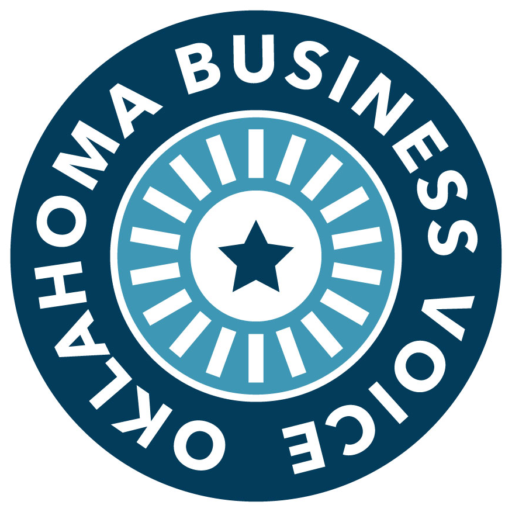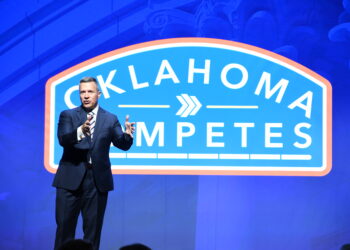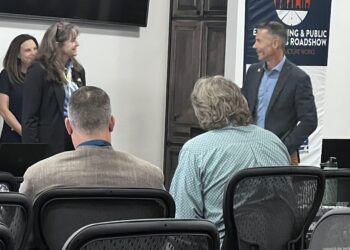TULSA, Okla. (OBV) – Business leaders from across state gathered in Tulsa last week for the Oklahoma Business Roundtable’s annual Membership Meeting, where the leaders delved into the results of this year’s Business Leaders Poll.
2025 Oklahoma Business Leaders Poll (BLP) is an annual collaboration from the The State Chamber of Oklahoma, the Oklahoma Business Roundtable and the State Chamber Research Foundation (SCRF). It’s a survey that probes Oklahoma’s business community, questioning business leaders and executives about the state of business, the economy, workforce and education. It also gauges business leaders on emerging issues such as artificial intelligence (AI).
BLP was released in May after it was meticulously developed by Pat McFerron, President of Cole Hargrave Snodgrass & Associates, a firm which provides state-of-the art data collection and experienced analysis to help its political, corporate and legal clients attain major opportunities through qualitative and quantitative research, delivering top quality data and providing actionable recommendations.
“[Pat] is probably the best pollster in the country. He does polls for states all over the U.S. and he has been great at this. We really do appreciate the fact that he’s done this for the last five years for us,” said Mark Funke, President and CEO of the Oklahoma Business Roundtable.
McFerron spoke at length during the meeting, discussing the results of the Business Leaders Poll, much of which concerned business leaders’ thoughts on workforce as well as their outlook on the future of business in the state.
The Business Leaders Poll seeks to create a comprehensive overview of business leaders’ top concerns and provide a guide for growth to the legislators who shape the state’s economic and business development initiatives.
This year’s Business Leaders Poll surveyed 302 business owners and executives across Oklahoma. The survey was concluded on April 1.
McFerron said he spoke with employers from across a wide variety of businesses
Oklahoma’s business leaders and executives are confident that Oklahoma’s economy is on the right track, according to McFerron.
“The good news is people believe that the state’s economy is going in the right direction — 70 percent — up a little bit from, last year, almost the same as it was in 2023,” he said. “They think that things are going in the right direction. I generally see business leaders more optimistic than the general public.”
Those business leaders are more optimistic about Oklahoma’s economy than they are about the national economy, according to this year’s Business Leaders Poll.
The outlook on investing in Oklahoma is another promising statistic from the poll. Eighty-eight percent of business leaders say they plan to invest in the state. Those same leaders say workforce availability is the primary barrier to investing.
“Only 10 percent say they won’t be making investments in Oklahoma,” McFerron said.
He said that’s a promising percentage, especially compared to Colorado, where 35 percent of business leaders said they did not plan to invest in their state.
“This 10 percent puts Oklahoma in the top three or four of the of the states that I’m dealing with. You only have that many of your people saying, ‘I’m not going to invest any more in Oklahoma,'” McFerron said. “You have 28 percent that say they’re going to invest in Oklahoma and somewhere else. I think that’s fine. But really, the key thing here is 88 percent that say they’re going to invest in Oklahoma.”
McFerron described workforce as the most important issue facing Oklahoma businesses.
Workforce has been the top concern among Oklahoma’s business leaders for the past few years, and it remained so this year. Twenty-one percent of those surveyed said workforce is their top concern. However, that percentage is down from 32 percent in 2024 and 34 percent in 2023.
Oklahoma’s economy, taxes, education and regulations are business leaders’ top concerns after workforce, the Business Leaders Poll found.
“More than one out of five [business leaders] immediately say the workforce [is their top concern]. And then we see the general economic concerns, taxes, education. I will tell you, education is workforce. And so, when you combine those two, you’ve got a really, really high number [of concerned business leaders],” McFerron said.
Oklahoma business leaders’ concern over workforce have continually declined since the end of the pandemic.
“But it’s still the top [concern] long term. And you see concerns about the economy are higher. And again, [concern over] taxes moving up as well, which we tend to see happen when there’s times of economic uncertainty,” McFerron said.
The concern over the economy pertains more to the U.S. economy rather than Oklahoma’s economy, McFerron said.
“This is another factor that I tend to see happening among [employers] with fewer than 100 employees. You see a greater concern about taxes than you do among larger companies, or the larger companies are really, really focused on workforce,” he said.
Employee recruitment and retention is a primary concern for Oklahoma employers who are worried about workforce, according to McFerron.
“Almost half [of those surveyed] mentioned it as their top concern,” he said.
Lt. Gov. Matt Pinnell spoke during the event, discussing the importance of the Oklahoma Business Roundtable, Gov. Stitt’s efforts to recruit new businesses to Oklahoma and the Roundtable’s invaluable role in helping bring prominent companies to the state.
Pinnell specifically cited CBC Global Ammunition and Emirates Global Aluminium as companies the Oklahoma Business Roundtable helped recruit to Oklahoma.
“We could not have done that without the Oklahoma Business Roundtable. Mark, thank you. You are demonstrating exactly why this organization exists,” he said.

















